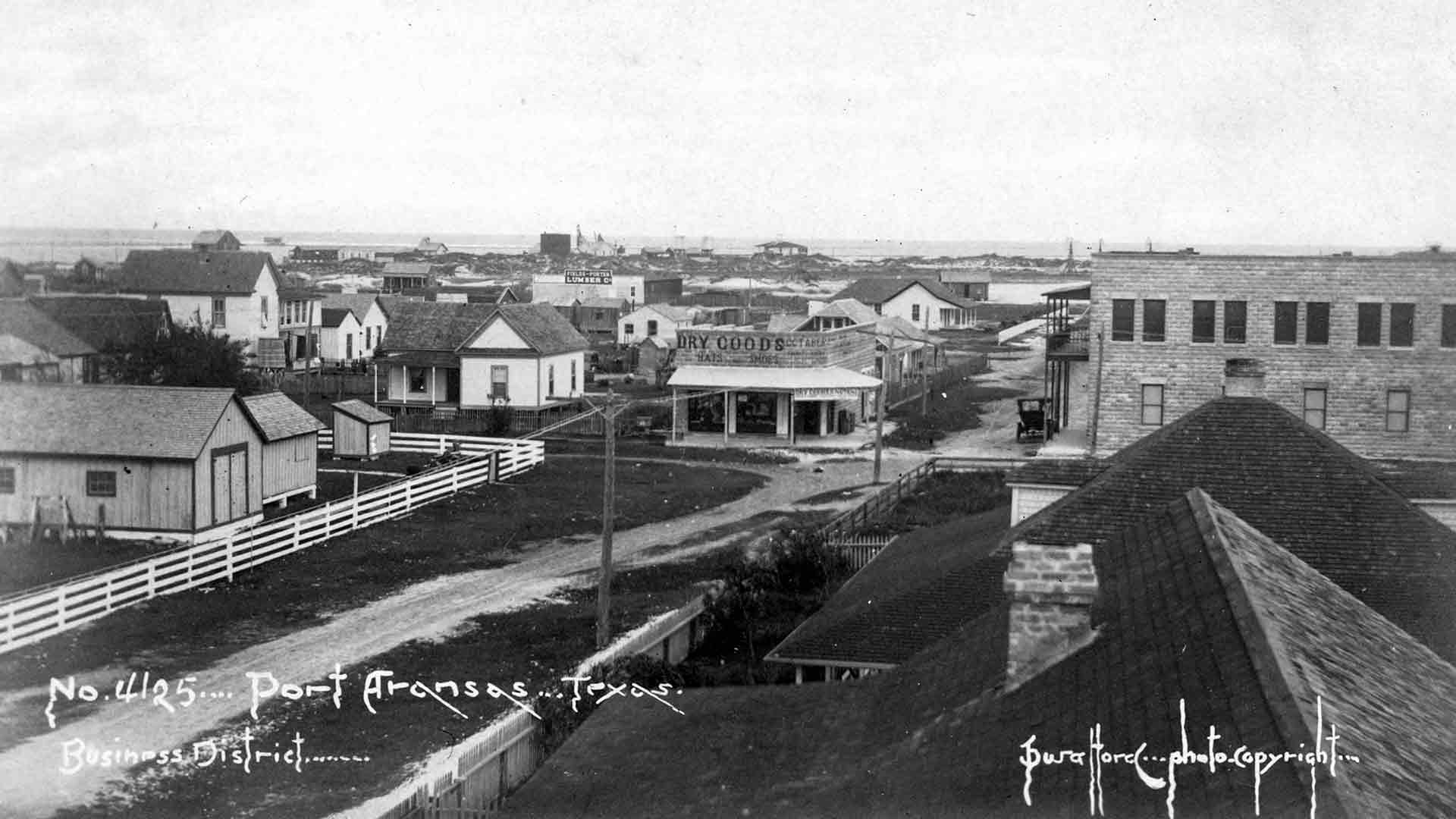
Pre-History to the Early 1900s
Port Aransas is located on the northern tip of Mustang Island. Experts believe the islands along the Texas coast began life as submerged sand bars about 4,500 years ago.
Karankawa Indians were likely our island’s first residents. They inhabited the Gulf Coast of Texas from Galveston Bay all the way to Corpus Christi Bay. The Karankawa led a nomadic existence, migrating from the mainland to the coast.
In 1519, Spanish explorer Alonzo Álvarez de Pineda, of the Spanish Navy sailed a tiny ship through a Pass between two outlying islands, and into a great bay. Having entered the bay on the feast day of Corpus Christi, Pineda promptly named it in honor of the day.
In 1534 other Europeans, Cabeza de Vaca and companions, who had been shipwrecked near modern Anahuac, were trying to reach a settlement in Mexico by following the coast line, when they came to Aransas Pass and paddled across it in a canoe.
It is rumored that Jean La Fitte and his band of buccaneers spent a lot of time on neighboring islands as well as Mustang Island in the 1820s. Legend has it that somewhere on the island is a Spanish dagger with a silver spike driven through the hilt marking the spot where La Fitte buried a chest of gold and jewels.
As the still natural pass attracted more and more commerce and updated charts were needed, there appeared an 1833 map which noted the location of what would become Port Aransas, and then called Sand Point. The pass was given the name Aranzazu, which later became Aransas. Through the 1840s the island and pass (now the Corpus Christi Ship Channel) were used by buccaneers, smugglers, merchants and immigrants seeking their (or others) fortune.
During the 1846-48 Mexican War a small fort was built on Mustang Island to guard the entrance to Aransas Bay. It was used until after the Civil War.
In the 1850s regular steamship service ran between Port Aransas and New Orleans. With the establishment of this steamship service route, the United States Congress commissioned $12,500 for the construction of the Aransas Pass Lighthouse. Haggling over lighthouse’s specifications mired down the process and another survey was done. Meanwhile, the pass slowly moved south as currents deposited sand on its north bank at the south end of St. Joseph Island. In December 1855, the ship transporting the bricks struck, and then stuck, on the bar. The crew mates were all rescued but the ship and its cargo went to the bottom of the sea. New bricks arrived in 1856, soon followed by the lantern room that would be set on top, and lastly a fourth-order Fresnel lens. The construction was completed by mid 1857 and the illuminated lens lightened the dark night, guiding ships through the pass later that year.
In 1878, the United States Life-Saving Service built a U.S. Life Saving Station in Port Aransas. The station was built for aid and rescue of shipwrecked mariners and was manned by full-time crews during the period when wrecks were most likely to occur. The Life Saving Service became the United States Coast Guard in 1915. Designated keeper in charge of the 8th District Life Saving Station on Mustang Island was John G. Mercer. He was also one of the local bar pilots.
The Lydia Ann Channel Lighthouse was deactivated in 1952 after a major channel shift left the station a mile from the channel entrance. To better mark Aransas Pass, a new light was established in 1952 at the Port Aransas Coast Guard Station, and the Aransas Pass Lighthouse was deactivated, just a few years shy of a century of service.
Early Settlement
In 1853 Robert A. Mercer (John Mercer’s brother) became the first permanent settler on Mustang Island established the El Mar Rancho in 1855. With his wife and three children he raised cattle and sheep, operated the Mercer Docks and later opened the first general store.
During the War Between the States Union forces occupied the island and most families moved to neighboring St. Joseph Island, returning to resettle the community after the war.
By 1870 the island was home to nearly 300 residents. The need to educate their children became a priority and within two weeks a one room school was built and a teacher hired for $10 a month!
The town on Mustang Island was called Ropesville by the early 1890s but changed its name to Tarpon by 1896. The population at that time was about 250. Citizens began calling their town Port Aransas about 1910. The storm of 1919 virtually wiped out the town except for a few structures.
A Community Develops
The island was first called Wild Horse Island, and then became Mustang, because of the wild horses called Mestenos, brought to the island by the Spaniards in the 1800s.
The town, after a succession of name changes — Sand Point, Star, The Pass, Mustang Island, Ropesville and Tarpon — became known as Port Aransas, and the treasure of unique and intriguing history grew:
- A Congressional Act in 1878 established a Life Saving Service on 1.55 acres of Mustang Island, the present site of the U.S. Coast Guard Station.
- The Tarpon Inn, built in the 1880s, became the hub of recreational fishing in Port Aransas. After several reconstructions and surviving five hurricanes from 1942 – 1970, the building is now listed on the U.S. Historical Registry.
- The internationally recognized University of Texas Marine Science Institute, founded in 1941, was Texas’ first permanent facility to study ocean life and science.
- Port Aransas was the nation’s 12th largest oil shipping port into the 1940s. During World War II this vital resource was protected against enemy attack by troops, dog patrols and 30mmm gun emplacements.
- Port Aransas hosts more than 35 fishing tournaments, including the Deep Sea Roundup (formerly the Tarpon Rodeo), and is the destination of the Annual Harvest Moon Regatta — the country’s largest sailing event.
- Beginning in the 1970s, protection and preservation of our dunes, beaches and wetlands acknowledged the value and beauty of the natural environment. With the coming of the 21st Century, Port Aransas developed The Port Aransas Nature Preserve at Charlie’s Pasture, a 1000+ acre wildlife sanctuary along the Corpus Christi Ship Channel side of the island.
At the turn of the century, the village was doing big business in sea turtle export with some catches weighing up to 500 pounds. They were shipped live, on their backs, to market. It is estimated that some 600+ species of saltwater fish inhabit the waters off the islands.
During the early 1900s, the abundance of Tarpon around Port Aransas began to attract visitors from all over the country. In the 1930s, President Franklin D. Roosevelt made several trips to the waters surrounding Port Aransas to go Tarpon fishing. Tarpon numbers plummeted and currently have a catch and release status.
The 2000 census showed a permanent population of 3,370. Port Aransas: 3370 (2000 Census) Registered Voters: 3,075 (2009). The 2010 census lists our population as 3,480.
Fishing has always been a staple, especially sport fishing for trout and redfish. It is estimated that some 600+ species of saltwater fish inhabit the waters off Port Aransas.
The popular beach at Port Aransas draws thousands of visitors each weekend from Memorial Day through Labor Day.
The Port Aransas economy continues to build upon its tourist driven economy by focusing on Eco-tourism. Three Birding Centers have been established by the city and State of Texas agencies. Additionally, several kayak paddling trails established by the State of Texas also contribute to visitors coming for eco-tourism related activities.



